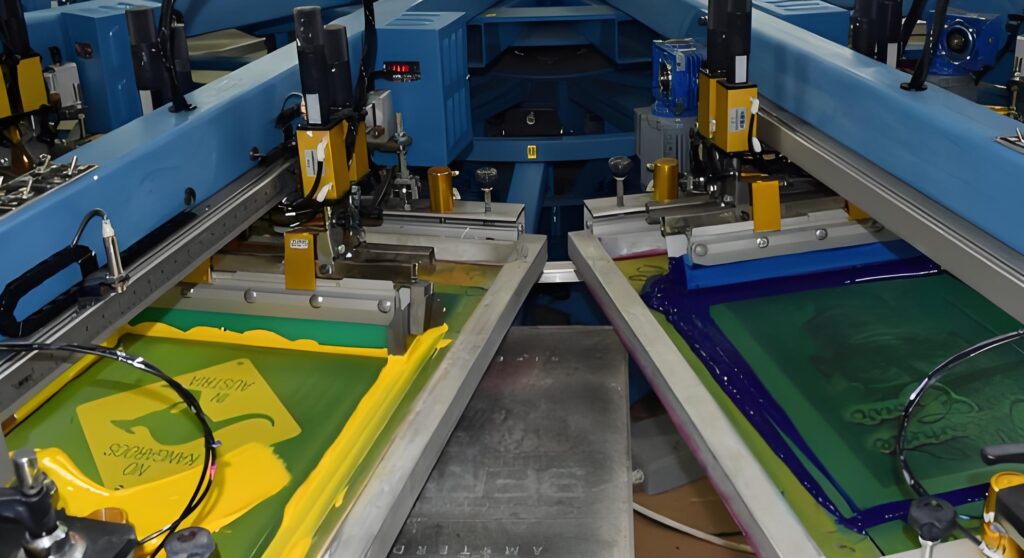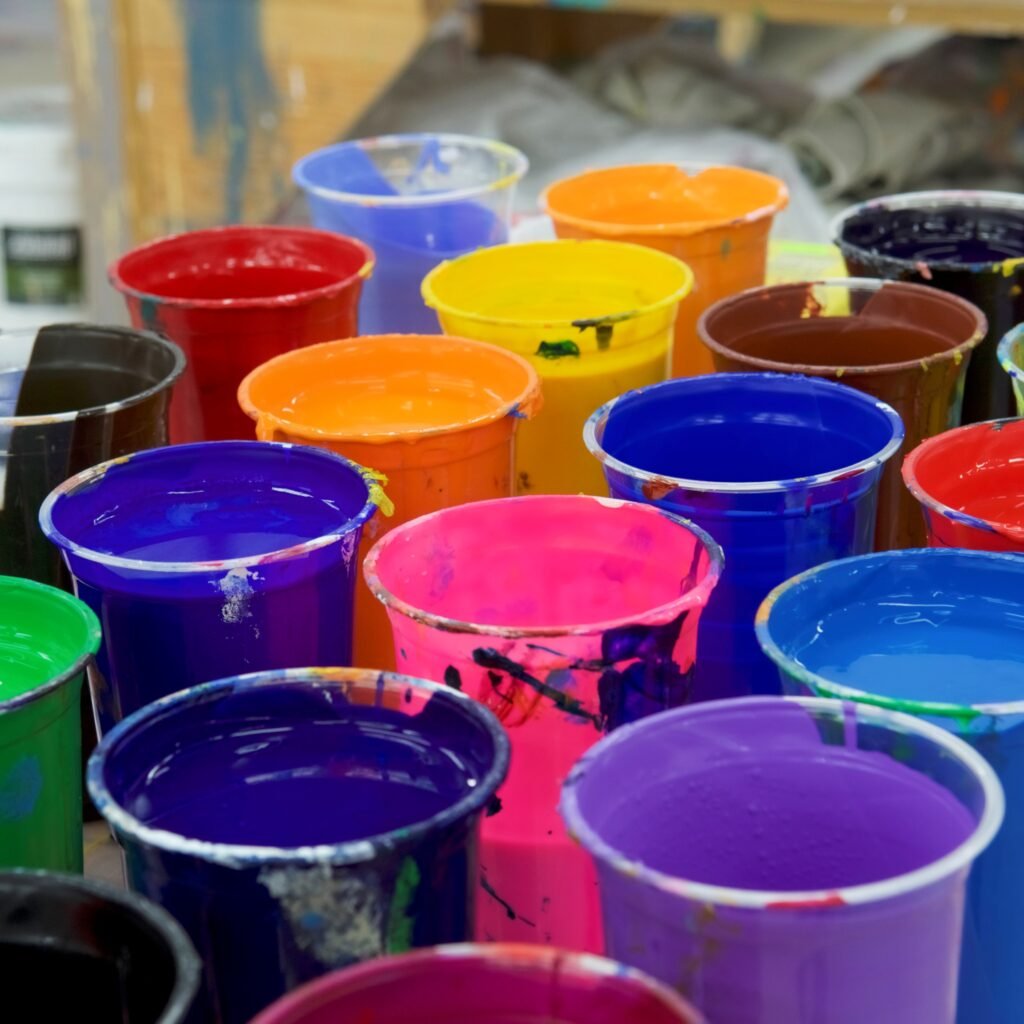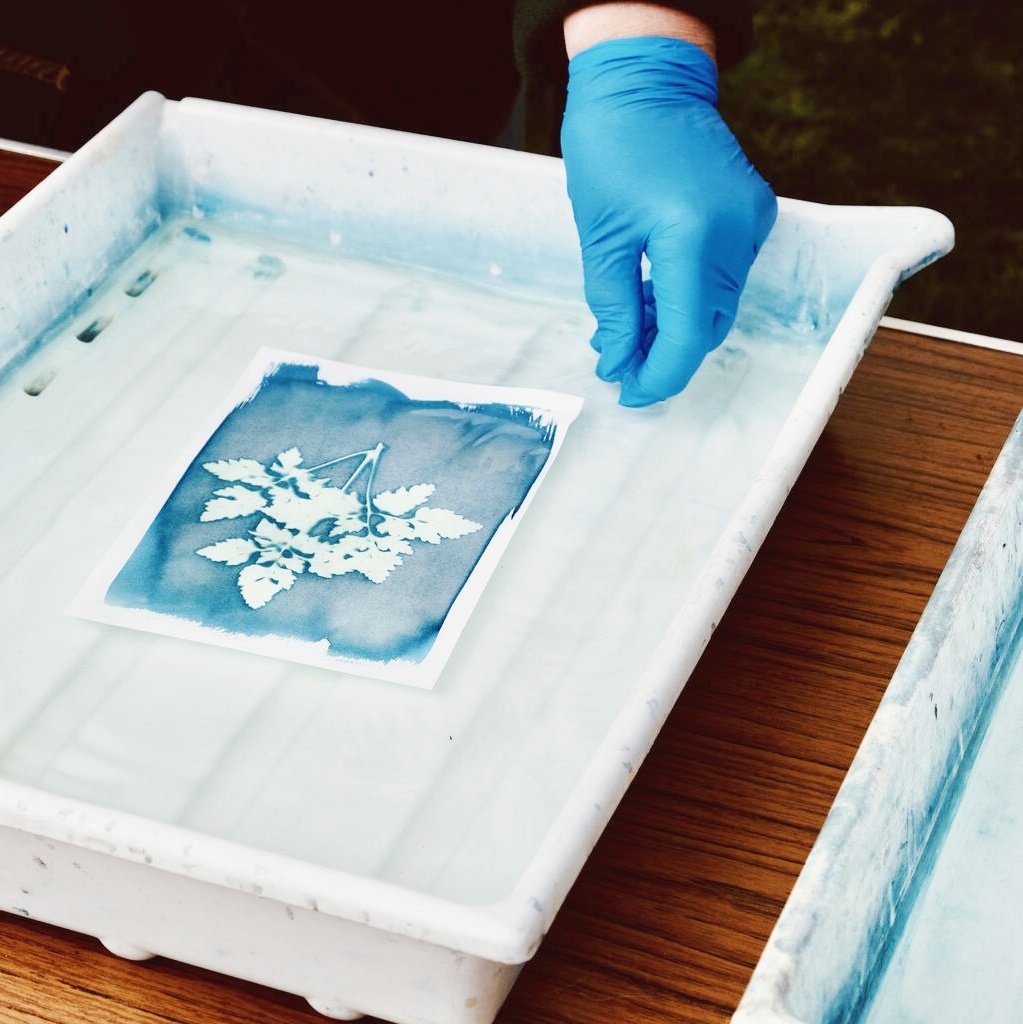การพิมพ์แบบน้ำพุเป็นวิธีการสร้างสรรค์และมีประสิทธิภาพในการสร้างเอฟเฟกต์ไล่เฉดสีโดยใช้หน้าจอเดียว ช่วยให้สามารถออกแบบได้เฉพาะตัวและไม่เหมือนใครโดยไม่ต้องใช้หน้าจอหลายจอ
แม้ว่างานพิมพ์แต่ละชิ้นจะมีข้อแตกต่างกันเล็กน้อย แต่ด้วยเทคนิคที่ผ่านการปรับปรุงทำให้สามารถผลิตงานพิมพ์แบบน้ำพุได้ทั้งสำหรับการผลิตจำนวนน้อยและจำนวนมาก
สารบัญ
สิ่งที่คุณต้องการ
เนื่องจากสีถูกผสมบนหน้าจอเดียว จึงไม่จำเป็นต้องสร้างหน้าจอแยกสำหรับแต่ละสี เพียงแค่เผาหน้าจอเดียวพร้อมกับการออกแบบก็เพียงพอแล้ว เตรียมสีหมึกเสริม — หมึกพลาสติซอล ขอแนะนำสำหรับการพิมพ์แบบน้ำพุ เนื่องจากมีความหนาและสามารถคงอยู่ในตำแหน่งได้
หมึกที่มีความหนา เช่น พลาสติซอล ช่วยลดการแพร่กระจายที่ไม่ต้องการในระหว่างกระบวนการพิมพ์ หลีกเลี่ยงการใช้สีที่เข้ากันบนหน้าจอเดียวกัน เนื่องจากอาจทำให้การพิมพ์ออกมาไม่สวยงาม
สีของเสื้อผ้าก็มีบทบาทสำคัญเช่นกัน ตัวอย่างเช่น หากคุณวางแผนที่จะพิมพ์ด้วยเฉดสีน้ำเงิน ให้หลีกเลี่ยงการใช้เสื้อผ้าสีน้ำเงิน เนื่องจากอาจมองไม่เห็นบางส่วนของการออกแบบ เลือกสีเสื้อที่จะช่วยขับเน้นหมึกที่คุณต้องการใช้
การตั้งค่าและการทดสอบ
การตั้งค่าการพิมพ์แบบน้ำพุแตกต่างจากการพิมพ์สกรีนแบบดั้งเดิม วางแถบหรือหยดหมึกบนหน้าจอโดยใช้ไม้พายหรือที่ขูด โดยเว้นระยะห่างระหว่างแต่ละสี อย่าเพิ่งผสมหมึก — สิ่งนี้จะเกิดขึ้นระหว่างการพิมพ์ทดสอบ
คำนึงถึงขนาดงานและปริมาณหมึก การใช้หมึกมากเกินไปในครั้งเดียวอาจทำให้หมึกผสมกันมากเกินไปหลังจากพิมพ์ไปแล้วประมาณ 10 ครั้ง ส่งผลให้เอฟเฟกต์การไล่เฉดสีลดลง นอกจากนี้ หมึกที่ผสมมากเกินไปยังทำให้นำกลับมาใช้ใหม่ได้ยากอีกด้วย
ระหว่างการทดสอบ ให้พิมพ์ซ้ำหลายๆ รอบ โดยปกติ 4-5 รอบ จนกว่าการไล่เฉดสีจะชัดเจนขึ้น ใช้ผ้าทดสอบหรือเศษผ้าเพื่อประเมินการผสมก่อนดำเนินการผลิต
เมื่อใดจึงควรทำความสะอาดหน้าจอ
หากการไล่เฉดสีเริ่มดูหมองหรือขุ่นมัวระหว่างการพิมพ์ แสดงว่าถึงเวลาทำความสะอาดหน้าจอและเติมหมึกใหม่ นี่เป็นอีกเหตุผลหนึ่งที่จะหลีกเลี่ยงการใช้หมึกมากเกินไปบนหน้าจอ เมื่อรีเฟรชหมึก คุณไม่จำเป็นต้องทำซ้ำลำดับสีเดิม คุณสามารถสลับลำดับหรือแม้แต่เพิ่มสีใหม่เพื่อให้ได้เอฟเฟกต์ใหม่
เทคนิคการใช้ไม้ปาดน้ำ
ในการพิมพ์หลายสีแบบดั้งเดิม มุมของไม้ปาดหมึกมักจะมีความสำคัญมากกว่าตำแหน่ง แต่ในการพิมพ์แบบน้ำพุ การวางไม้ปาดน้ำให้สม่ำเสมอเป็นสิ่งสำคัญการเลื่อนไปทางซ้ายหรือขวาระหว่างการดึงจะทำให้การผสมหมึกเสียหายและส่งผลต่อการไล่ระดับสี
การใช้ จังหวะการดึง ขอแนะนำ การดึงจะช่วยให้ควบคุมแรงกดและการไหลของหมึกได้ดีขึ้น ซึ่งถือเป็นสิ่งสำคัญสำหรับการจัดการการไล่ระดับสี ความสม่ำเสมอคือสิ่งสำคัญ ให้การเคลื่อนไหวของคุณคงที่ตลอดการพิมพ์
ความเป็นไปได้เชิงสร้างสรรค์
การพิมพ์แบบน้ำพุช่วยส่งเสริมเทคนิคสร้างสรรค์ตามธรรมชาติ คุณสามารถทดลองใช้การเคลื่อนไหวของไม้ปาดหมึกเพื่อสร้างเอฟเฟกต์ที่กำหนดเองได้:
- จังหวะคลื่น สร้างการไล่ระดับสีแบบไหลลื่น
- การดึงแบบวงกลม (หมุนไม้ปาด) ขึ้นรูปเป็นรูปทรงเรเดียล
- เอฟเฟกต์ลายหินอ่อน สามารถสร้างได้โดยการแต้มสีต่างๆ ในปริมาณเล็กน้อยลงบนหน้าจอและดึงผ่านเพียงครั้งเดียว
สามารถใช้หมึกทาแบบสุ่มหรือแบบมีกลยุทธ์ได้ ขึ้นอยู่กับวิสัยทัศน์ทางศิลปะของคุณ
ไม่มีข้อจำกัด — การพิมพ์แบบน้ำพุช่วยให้คุณมีพื้นที่ในการสำรวจและสร้างสรรค์สิ่งใหม่ ๆ
สถานการณ์การใช้งาน
การพิมพ์สกรีนแบบน้ำพุเหมาะสำหรับทั้งการใช้งานทางศิลปะและเชิงพาณิชย์ ความสวยงามที่เป็นเอกลักษณ์ทำให้เหมาะเป็นพิเศษสำหรับ:
- สินค้ามีจำนวนจำกัด – ลายพิมพ์แต่ละชิ้นจะมีลวดลายที่แตกต่างกันเล็กน้อย เพื่อเพิ่มความพิเศษ
- เครื่องแต่งกายสำหรับงานอีเว้นท์ – สร้างการออกแบบที่สะดุดตาสำหรับเทศกาล คอนเสิร์ต หรือกิจกรรมของบริษัท
- งานพิมพ์ศิลปะและโปสเตอร์ – การพิมพ์แบบน้ำพุสามารถนำไปใช้กับกระดาษได้เช่นกัน ทำให้เป็นที่นิยมในหมู่ศิลปินภาพและนักวาดภาพประกอบ
- แบรนด์สตรีทแวร์และแฟชั่น – การพิมพ์แบบไล่เฉดสีโดดเด่นในตลาดที่มีการแข่งขันสูง ช่วยให้นักออกแบบสามารถสร้างเอกลักษณ์เฉพาะของแบรนด์ได้
คุณสามารถผสมผสานการพิมพ์แบบน้ำพุกับเทคนิคอื่นๆ เช่น การเติมสีแบบพัฟ การซ้อนฟอยล์ หรือการปัก เพื่อสร้างเอฟเฟกต์ไฮบริดที่ไม่ซ้ำใครอย่างแท้จริง
การแก้ไขปัญหาและข้อผิดพลาดทั่วไป
แม้แต่ช่างพิมพ์ที่มีประสบการณ์ก็อาจประสบปัญหาได้ ต่อไปนี้เป็นปัญหาทั่วไปบางประการและวิธีแก้ไข:
- หมึกซึมหรือผสมมากเกินไป
สาเหตุ: การใช้หมึกมากเกินไปบนหน้าจอหรือใช้แรงปาดหมึกที่ไม่สม่ำเสมอ
สารละลาย: ใช้หมึกน้อยลงและรักษาแรงกดให้คงที่สม่ำเสมอในระหว่างการพิมพ์ - การไล่ระดับสีแบบซีดหรือทึบ
สาเหตุ: สีหมึกใกล้เคียงกันเกินไป หรือหน้าจอมีการผสมสีมากเกินไป
สารละลาย: ควรเติมหมึกเป็นประจำ และเลือกสีที่มีความคมชัดมากขึ้น - การพิมพ์ที่ไม่สม่ำเสมอกันในแต่ละชุด
สาเหตุ: การเปลี่ยนมุมหรือแรงกดของไม้ปาดน้ำ
สารละลาย: ทำเครื่องหมายตำแหน่งไม้ปาดน้ำหรือใช้ตัวนำเพื่อรักษาความสม่ำเสมอ - การปนเปื้อนของสี
สาเหตุ: การใช้หมึกชนิดที่ไม่เข้ากันหรือไม่ทำความสะอาดเครื่องมือระหว่างงาน
สารละลาย: ให้ใช้พลาสติซอลต่อไปหรือตรวจสอบให้แน่ใจว่าหมึกที่ใช้ทั้งหมดเข้ากันได้ และทำความสะอาดเครื่องมืออย่างทั่วถึงหลังการพิมพ์แต่ละครั้ง
เคล็ดลับเพื่อผลลัพธ์ที่ดีขึ้น
- บันทึกกระบวนการของคุณ – จดบันทึกหรือถ่ายภาพตำแหน่งของหมึกและทิศทางการดึงเพื่อช่วยจำลองการออกแบบที่ประสบความสำเร็จ
- ใช้เครื่องหมายจดทะเบียน – แม้แต่กับงานพิมพ์ที่เป็นศิลปะ การจัดวางตำแหน่งบางอย่างสามารถช่วยให้ทำซ้ำได้
- เริ่มต้นด้วยสีน้อยๆ – การเชี่ยวชาญสองหรือสามสีจะทำให้การเรียนรู้เทคนิคต่างๆ ง่ายขึ้น
- เล่นกับเนื้อผ้า – การไล่เฉดสีของน้ำพุจะดูแตกต่างกันบนผ้าฝ้าย ผ้าผสม หรือผ้าพิเศษ — ทดลองเพื่อค้นหาเอฟเฟกต์ที่คุณชอบที่สุด
ความคิดสุดท้าย
การพิมพ์สกรีนแบบน้ำพุให้ความสมดุลที่สมบูรณ์แบบระหว่างโครงสร้างและความเป็นธรรมชาติ ช่วยให้ช่างพิมพ์มีโอกาสหลีกหนีจากบรรทัดฐานการผลิตที่เข้มงวดและเปิดรับความงามของความหลากหลาย ด้วยอุปกรณ์เพียงเล็กน้อยและการทดลองสร้างสรรค์เพียงเล็กน้อย คุณสามารถบรรลุผลลัพธ์ที่มีชีวิตชีวา มีสีสัน และเป็นเอกลักษณ์เฉพาะตัวของคุณ
ไม่ว่าคุณจะเป็นช่างพิมพ์สกรีนผู้มากประสบการณ์ที่กำลังมองหาอะไรใหม่ๆ หรือเป็นมือใหม่ที่กำลังศึกษาเทคนิคการแสดงออก การพิมพ์แบบน้ำพุก็เป็นวิธีที่คุ้มค่าที่จะฝึกฝนให้เชี่ยวชาญ
จดจำ: ไม่มีการพิมพ์สองแบบที่จะเหมือนกันเป๊ะๆ และนั่นคือส่วนหนึ่งของความมหัศจรรย์
ชาลิไทน์ กระตุ้นให้คุณหลีกหนีจากกิจวัตรประจำวันและลองพิมพ์แบบน้ำพุดู ด้วยเทคนิคที่สม่ำเสมอและการทดสอบที่เหมาะสม คุณสามารถสร้างผลงานที่น่าทึ่งด้วยการตั้งค่าขั้นต่ำแต่ให้ผลลัพธ์สูงสุด



